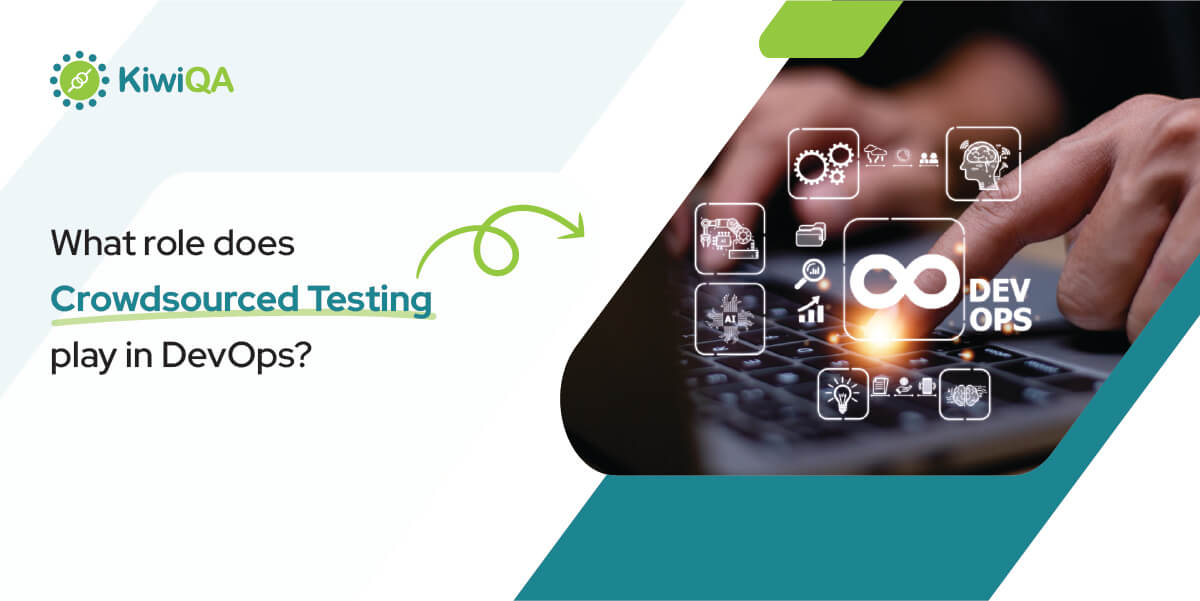What Role Does Crowdsourced Testing Play in DevOps?

 KiwiQA
KiwiQATable of Contents
A developer’s most extraordinary sense of fulfilment is knowing they have given their customers a high-quality product or service. Vigorous testing is required throughout the development process from end-to-end delivery to offer this quality assurance. The testing capabilities of a typical enterprise IT development team are becoming increasingly limited as technology trends quickly shift to cloud services and digital devices. It becomes quite challenging for them to keep up with the innovation as they must deal with rapid launches of increasingly complicated items.
Since crowd testing services is a popular choice for the testers to supplement testing procedures, current Quality Assurance teams are increasingly using crowdsourced software testing toolkits and services as a substitute. Also, companies are merging team members with strategy groups that create test strategies and approaches, automate processes, and manage crowdsourcing tools. Before we delve into the article, let’s get a quick idea about crowdsourced testing and DevOps.
A testing technique that essentially uses the community’s strength is called crowdsourced testing or crowd testing. This testing method uses individuals or groups and desired devices to perform various testing tasks in actual settings. As a result, this testing tool not only aids in bug and issue detection but may also give you invaluable user experience input that standard automated testing cannot. Additionally, it may produce test-team results that resemble the functionality of a few QA development test teams at part of the expense of managing and maintaining that sort of Quality Assurance infrastructure in the past. It also helps to focus and target the problem, speeding up the code review and mitigation process.
The toolset of Crowd Testing can assist in meeting simple IT budgetary requirements for defending ROI or Total-Cost-of-Ownership business support kudos to automated script-testing, synthetic user transaction functionality, widespread crowd testing participation, and more comprehensive user and system base of compatibility testing. This testing solution may be the most excellent option for dealing with team resource issues in light of tightening audit control rules and declining IT expenditures.
The implications of crowdsourced testing software are numerous and most beneficial to DevOps teams. Firstly, it enables businesses to collaborate with qualified testers proficient in several contexts, languages, and devices. These testers can also be scaled up or down if necessary. Additionally, the testers in crowdsourcing tend to be fair because they are not in contact with any organization.
Before making a product available to the general public, companies enable developers to get direct consumer insights regarding software, websites, applications, and their intended endpoints. Moreover, should any mistakes arise during the testing process, developers may review those logs if the crowdsourced testing solution also records logging. Test automation software and user testing can function along with other software testing tools. Given that human analysis is used instead of automated checks, you can compare crowdsourced testing to an external version of peer code review software.
DevOps is a revolutionary technological, people, and culture shift. It emphasizes teamwork and responsibility-sharing while preserving a seamless communication line between everyone involved, encouraging and enabling organizations to implement their customer-driven business needs. Automated practices optimize procedures to yield better application after each cycle.
To create a collaborative working ecosystem between the development and management teams, DevOps is dismantling organizational silos. An application’s buildout benefits from conceptualizing and designing through execution and deployment by removing departmental and hierarchical walls and hurdles. DevOps and automation work hand in hand to help meet the persistent demands generated by today’s dynamic IT environment. You will need human intellect for remarkable tasks while technology replaces routine jobs.
It seems fascinating, and crowdsourcing is a new method for the DevOps community to work closely. Since DevOps has backlog items, crowdsourcing aid in developing, creating, and delivering the new features. Early strategic intent and vision definition is necessary for crowdsourcing innovation. The first and foremost step is to implement the DevOps features. Other fascinating applications of crowd testing includes ideating a roadmap and validating new features. Understanding and interacting with the appropriate persona types is crucial from a crowdsourcing standpoint.
When we look for what automation in software testing can do well, the first thing that comes to mind is writing and running suitable testing scripts, carrying out frequent test runs, and discovering loopholes that a naked eye might overlook. Automation offers depth and detail, but it lacks a creative vision. As a result, personal oversight cannot eliminate from a software development process. Crowdsourced testing may be able to help in this situation. The Crowdsourced software plays the function of pseudo-automation and may combine the speed of automated tools with the innovation of human testers in actual test settings.
When you start crowdsourcing, a unique Continuous Integration and Continuous Delivery (CI/CD) pipeline splits itself across several crowd testers. All team members of a crowd testing company work together in the same software development environment as the DevOps technique. Considering crowdsourcing comprises testers from several diversified remote locations, collaborating on the same project contradicts this deception. It can consume plenty of time to coordinate and communicate with all of these remote testers, which ultimately goes against the DevOps ideology of cooperation at speed and creates a peculiar scenario for DevOps professionals responsible for delivering high-quality products after each cycle.
The crowdsourced testers and the companies employing their services must remove Communication barriers to overcome the abovementioned issue. To ensure that the crowd testers use appropriate QA techniques, explicitly defining the user requirements before starting the testing process is essential. Regularly scheduled input is critical in determining whether the remote testing team is moving on the correct path. Additionally, frequent feedback enables developers to incorporate modifications to the code immediately and finish the cycle within the predetermined period.
One of the best tools for a crowd-testing company is cloud technology. It significantly lowers the expenses by eliminating the requirements for extensive infrastructure. The growing awareness of the cloud among businesses and entities has been a significant driver in the evolution of crowd testing. Gathering information and sharing them has become simple for crowd testers because of cloud-based platforms and data centres. Furthermore, it is much simpler via the cloud to make data management more accurate and change integration as quickly as possible.
Since many firms are switching to the DevOps approach, it leads to massive discrepancies in the skill sets of the existing resources. A company’s software development team may not always possess the necessary skill sets. In these circumstances, crowdsourcing the testing operations is found to be beneficial. Companies should hire remote testers with the capabilities lacking in their technical teams, enabling a comprehensive DevOps testing strategy.
Regarding security, it is impossible to overstate in the contemporary dynamic technological world. The tech experts are continually facing emerging security concerns due to technology advancement and IoT evolution. Higher security issues with more modern technologies necessitate stricter data protection. In a DevOps environment, the whole technical team has no less but adequate responsibility for developing a secure application, giving rise to the idea of DevSecOps. In the current cybersecurity environment, using crowd testing is equivalent to serving the application up to malicious users. Although there are hazards, it’s impossible to succeed in business without taking the initiative.
While scalability is the ultimate aim of DevOps adoption, thus automation is a crucial task. A testing company potentially harness the skillset of many competent testers through crowdsourcing without actually employing them. Scaling the business does not require spending money on management systems, planning strategies and infrastructure investments. It can easily be put to work by crowdsourced testing. Companies should efficiently extend their teams and operations while accelerating time to market along with versatility, reliability and speed to make DevOps more scalable and automation easy.
Receiving a software’s regular feedback amid various real-world environment circumstances and network situations is made feasible by the crowdsourced testers’ remote locations and global diversification. Furthermore, to give direct input on the user experience, crowd testers can be very helpful in determining how well software can sustain heaps of data workload, allowing the technical team to adjust the software’s performance accordingly.
The IT industry is engaged in a continual innovation cycle ranging from massive data centres to complete cloud solutions and manual to automated. As companies increasingly recognize the relevance of DevOps, its adoption is rising. It has become associated with high-calibre apps and software as it has gained popularity. Crowd testers are developing an approach to application QA that goes above and beyond automation. Crowdsourcing a company’s quality assurance and testing procedures has more benefits than drawbacks, notwithstanding the general fear caused by privacy concerns.
Crowd testing services fit better with DevOps since it is more adaptable than fixed, making it a savvy and economical quality control method. Although everyone should not use crowdsourcing, it is not a binary choice. However, it is a fantastic method to incorporate a little amount of automation into your operations and handle the rising burden. And most significantly, make your QA team into a model tester capable of concentrating on broader QA elements and joining the DevOps concept.
Join the like-minded community & get the latest updates and insights on software testing technological transformation around the globe. Don't miss out.
